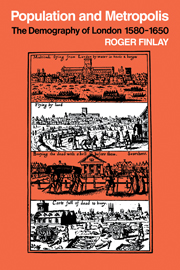Book contents
- Frontmatter
- Contents
- List of tables
- List of figures
- Preface
- 1 Introduction: The magnet of the metropolis
- 2 The accuracy of the London parish registers
- 3 The general growth of population in London
- 4 London social structure in 1638
- 5 The measurement of mortality rates
- 6 The effect of plague on mortality experience
- 7 Marriage and fertility
- 8 Population and metropolis
- Appendix 1 The London bills of mortality
- Appendix 2 Baptisms and burials in sample London parishes
- Appendix 3 Details from the 1638 listing and administrative divisions of London
- Appendix 4 London population in 1631 and houses in 1638 by wards
- References
- Index
6 - The effect of plague on mortality experience
Published online by Cambridge University Press: 06 July 2010
- Frontmatter
- Contents
- List of tables
- List of figures
- Preface
- 1 Introduction: The magnet of the metropolis
- 2 The accuracy of the London parish registers
- 3 The general growth of population in London
- 4 London social structure in 1638
- 5 The measurement of mortality rates
- 6 The effect of plague on mortality experience
- 7 Marriage and fertility
- 8 Population and metropolis
- Appendix 1 The London bills of mortality
- Appendix 2 Baptisms and burials in sample London parishes
- Appendix 3 Details from the 1638 listing and administrative divisions of London
- Appendix 4 London population in 1631 and houses in 1638 by wards
- References
- Index
Summary
The mortality rates for London parishes which have been presented so far refer to the background level of mortality and do not include the effect of the plague epidemics. There were very serious plague crises in 1563, 1593, 1603, 1625 and 1665, and a lesser outbreak in 1636. There were relatively few plague deaths outside these years, but in the worst crises the annual death rate was well over 200 per thousand. In this chapter it will be argued that it is easy to misunderstand the effect of plague. The continuous supply of migrants from the countryside meant that even when the crisis mortality rate was so high, the population was replenished very rapidly after the end of the outbreaks. Outside these plague years, the great majority of deaths in London may be attributed to other diseases, and the disappearance of plague did not necessarily lead to a significant narrowing of the gap between deaths and births. The crises themselves, however, were very serious for their duration, and, as with mortality in general, their impact was unequally distributed between the different areas of the city.
Despite the social dislocation caused by its occurrence, plague was a relatively infrequent epidemic disease, although it was also endemic for much of the period in some of the poorer parts of the city. As T. McKeown has recently written:
By simple arithmetic it can be shown that a high death rate from an infrequent epidemic infection has much less effect on the general level of mortality and rate of population growth than the constant high death rate from endemic infections which killed the majority of all newborn children within ten years of birth.
- Type
- Chapter
- Information
- Population and MetropolisThe Demography of London 1580–1650, pp. 111 - 132Publisher: Cambridge University PressPrint publication year: 1981
- 2
- Cited by



